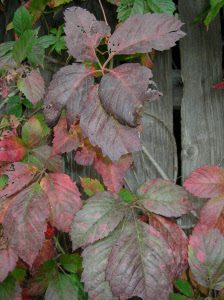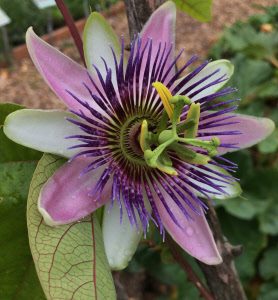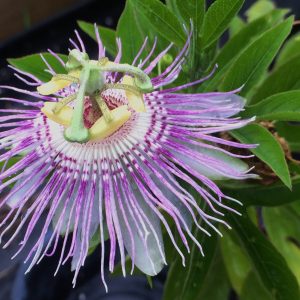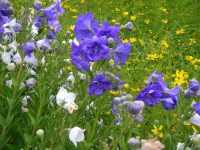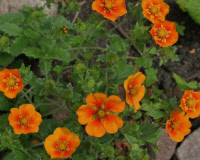Archives
Showing 113–120 of 164 results
-
Parthenocissus quinquefolia Virginia creeper Z 3-9
Brilliant scarlet in autumn
ARCHIVED
Note: This is a plant not currently for sale. This is an archive page preserved for informational use.
Spring leaves bronzy, turn green in summer and then brilliant scarlet in autumn, with contrasting blue berries with red stems.
Size: 50’ x 10'
Care: Either sun or shade in well-drained soil
Native: Eastern No. America
Awards: England’s Royal Horticultural Society Award of Garden Merit.Parthenocissus is Greek meaning “virgin ivy.” Cultivated in American gardens since 1700’s. Sent to England by English planthunter Tradescant the Younger in the 1640’s. Grown by Jefferson.
-
Passiflora caerulea Blue passion flower Z 6-9
Exotic, large blossoms with an outer ruffle of petals and sepals
ARCHIVED
Note: This is a plant not currently for sale. This is an archive page preserved for informational use.
Exotic, large blossoms with an outer ruffle of petals and sepals; an inner disc of concentric rings of blue, white and purple filaments; and a central “antenna.” From mid-summer through fall.
Size: 15’ x 4’
Care: sun in well-drained soil
Native: So. America
Wildlife Value: Host for several butterfly caterpillars
Awards: Royal Horticultural Society Award of MeritSince at least 1753
-
Passiflora incarnata Maypop Z. 5 (with protection)-9
Abundant, extremely showy lavender and white flowers all summer then egg size yellow fruit that you can eat. Most hardy of the passionflowers.
ARCHIVED
Note: This is a plant not currently for sale. This is an archive page preserved for informational use.
Abundant, extremely showy lavender and white flowers all summer then egg size yellow fruit that you can eat. Most hardy of the passionflowers.
Size: 10-15’ x 18”
Care: sun in moist soil
Native: Eastern US
Wildlife Value: Attracts butterfliesCollected by Rev. John Banister who moved to colonial Virginia in 1678. A gunman mistakenly shot and killed him while he collected plants. Pressed specimen in Emily Dickinson’s herbarium. Dies back to ground in winter only to pop out of the ground in May, hence “Maypop.”
-
Philadelphus lewisii Lewis’ Mock Orange Z 4-9
A triple delight. From late spring to early summer clusters of 2” wide, four-petaled, snow-white flowers with a center boss of sunny stamens smother this vase-shaped shrub. The flowers perfume the air with a delicious, orange scent. Then in fall the foliage turns citrus-yellow. Idaho adopted this as the state flower.
A triple delight. From late spring to early summer clusters of 2” wide, four-petaled, snow-white flowers with a center boss of sunny stamens smother this vase-shaped shrub. The flowers perfume the air with a delicious, orange scent. Then in fall the foliage turns citrus-yellow. Idaho adopted this as the state flower.
LIMITED QUANTITES AVAILABLE, LIMIT OF 1 PER CUSTOMER PLEASE.
Size: 5-10’ x 5-7’
Care: sun to part-shade in moist to well-drained soil
Native: from British Columbia to California, east to Montana.
Wildlife Value: Nectar and pollen attract bumble bees, moths, butterflies and hoverflies. It hosts caterpillars and chrysalises. Many birds eat the seeds.Natives used its strong and hard wood to make arrows, bows, combs, pipes for smoking, snowshoes, clubs, armor to protect chests, fishing spears, harpoon shafts, sticks for digging, knitting needles and baskets. Meriwether Lewis collected this plant in two places, in early May 1806 in Nez Perce County Idaho and two months later in Missoula County, Montana.
-
Platycodon grandiflorus double Double Balloon flower Z. 3-9
Balloon shaped buds opening to double blue bells from mid-summer to early fall
ARCHIVED
Note: This is a plant not currently for sale. This is an archive page preserved for informational use.
Balloon shaped buds opening to double blue bells from mid-summer to early fall, longer if deadhead.
Size: 24” x 12”
Care: sun to part shade in moist well-drained soil
Native: Eastern Asia
Wildlife Value: attracts bees & butterfliesPlatycodon is Greek from platys meaning “broad” and kodon meaning “bell”, referring to the shape of the flower. This double form since 1800’s.
-
Pollia japonica Z 5-8 Yabumyooga in Japanese
Whorls of white flowers on a stalk above foliage blooming in July-August turn to blue berries in fall, oblong, foot-long, shiny foliage resembling ginger leaves.
ARCHIVED
Note: This is a plant not currently for sale. This is an archive page preserved for informational use.
Whorls of white flowers on a stalk above foliage blooming in July-August turn to blue berries in fall, oblong, foot-long, shiny foliage resembling ginger leaves.
Size: 1-3’ x 1-3’ spreads by rhizomes
Care: part to full shade in medium to moist soil
Native: Forests in China, Taiwan, Korea and JapanCollected by Thunberg by 1784. Used medicinally in Asia to treat colds and vertigo.
-
Potentilla argyrophylla Cinquefoil Z 5-8
Sunshine colored saucers with orange centers in early summer
ARCHIVED
Note: This is a plant not currently for sale. This is an archive page preserved for informational use.
Sunshine colored saucers with orange centers in early summer
Size: 24” x 24”
Care: sun in well-drained soil
Native: Nepal, China, Pakistan & AfghanastanPotentilla is Latin meaning powerful referring to medicinal properties. Argyrophylla means silver leaved. Potentillas used by dentists in the 16th century to reduce pain according to Gerard, English herbalist. Per Culpepper, 17th century English herbalist potentilla is to be used if Jupiter is ascending and the moon is “applying to him.” This species collected by 1831.
-
Potentilla hippiana Woody cinquefoil Z 4-8
Small clusters of yellow flowers atop fuzzy, toothed edged leaves
ARCHIVED
Note: This is a plant not currently for sale. This is an archive page preserved for informational use.
Small clusters of yellow flowers, July-August, atop fuzzy, toothed edged leaves
Size: 5-20” x 12"
Care: full sun in well-drained to moist well-drained soil
Native: Central & Southeast USA & much of Canada
Wildlife Value: Bee plantJohann Georg Lehmann (1792-1860) named this species in 1827 from a specimen collected by Edwin James in 1820 near the “sources of the Platte”. Carl Hippio was, in Weber’s words, “a revered colleague of Lehmann”

